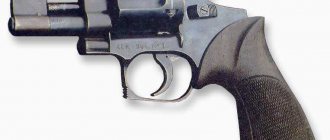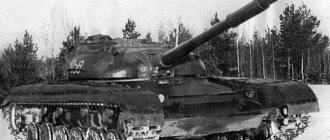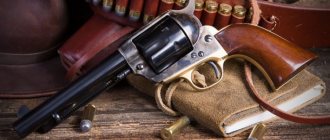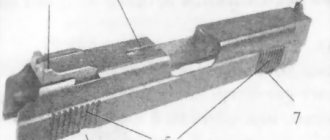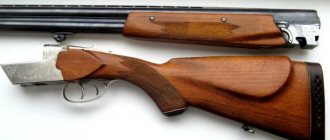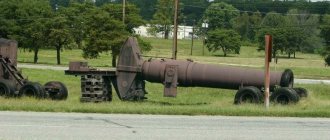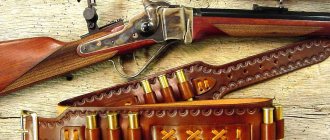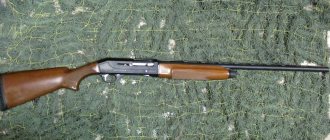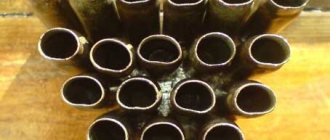Description
The Glock 26 is the company's subcompact pistol, chambered in 9x19 mm NATO caliber. Just like the “ancestor” of the series, the body of the pistol is made of composite - a polyamide base, with reinforcing elements fused into it, which has a positive effect on its strength and weight. Also, the ergonomics of the weapon have not undergone any significant changes - owners of “full-scale” pistols from the Austrian company do not experience any particular difficulties when operating the compact model.
Due to its size, the Glock 26 is loved not only by civilians, but also by members of various special forces around the world.
Firearm sound suppressors from the First World War.
Many designs of silencers appeared during the First World War. proposed a successful design in 1914. In Russia, mufflers were successfully developed by A. Ertel, who proposed his design in 1916. In the USSR, mufflers were developed by Markevich, Korolenko, Gurevich, and later by the Mitina brothers, the “Bramit” device.
Before the Second World War, this area of military technology did not receive significant development, since combat tactics did not provide for the covert destruction of enemy personnel at short distances, with the exception of guerrilla actions. This explains the absence of silent weapons in the armies of the world and the Red Army until the mid-30s, although the designs of various “sound suppressors” were described in textbooks for schools of weapons technicians back in 1934.
Design
Technically, the Glock 26 is similar to its ancestor (Glock 17), although there are very noticeable differences in the return mechanism. The subcompact's automatic system operates due to the short-stroke recoil of the barrel. The barrel bore is locked by the interaction of the protrusions on the breech of the barrel with the grooves on the inside of the bolt casing. The pistol does not have external mechanical safeties located on the outer surfaces of the pistol.
To avoid making the gun unnecessarily complex, the company's engineers used a telescopic return mechanism with two springs.
The telescopic return mechanism consists of two elements - the main rod and the coupling, connected by a spring. To soften recoil, two springs are installed on the mechanism - one softens the blow during the return movement of the bolt casing, the second acts as a returner. The shutter housing itself has slightly rounded front edges for greater inconspicuousness when worn under clothing.
The USM is a striker type with pre-cocking, equipped with three automatic shot blockers (safeties). One is traditionally located on the trigger, the rest are automatic. Full cocking of the striker occurs only when the trigger is fully squeezed, which allows you to keep the trigger resistance at the level of 2.4-2.6 kg for both the first and all subsequent shots.
Sights are represented by standard removable front sight and rear sight, also adapted for night shooting, having received the designation of a luminous mark on the front sight and U-shaped finishing of the rear sight slot.
Feeding in combat can be carried out either from a standard 10-round magazine with a staggered arrangement of cartridges, or from any magazine of the Glock family with a capacity of 12 to 33 rounds. At the same time, the handle is covered with only two fingers, which causes some inconvenience for inexperienced shooters, and also slightly increases the recoil when firing.
Without sound and flame
Without sound and flame
Work on devices for “silencing the sound of a shot” began at the end of the 19th century. - following the introduction of smokeless powders. At that time, two directions for solving the problem were outlined: cutting off the powder gases and “locking them” in the closed volume of the barrel bore of the cartridge case, or preliminary expansion and cooling of the gases before their release into the atmosphere.
The gas cut-off principle was proposed in 1889 by the inventor Janzen. According to his idea, when firing, the end of the barrel was closed with a wad, and because of this, the gas pressure was released slowly after the shot. In 1898, the French Colonel Humbert created a mechanical silencer - a rather curious mechanical device for cutting off the exit of powder gases from the barrel after a bullet leaves it. The device was installed at the end of the barrel and included a chamber with a valve and outlet channels for gases. In the “gun” version, the valve was a massive plate hinged on a transverse axis. After the projectile left the barrel, the gases that followed it lifted the plate and pressed it against the muzzle hole.
General view and structure of the gun block without flame of Humbert's design
In the “shooting” version, instead of a plate, a ball was used, lifted from its socket by a gas flow and blocking the muzzle.
Tests of these devices have not shown that “the flame is barely visible, the rumble is weakened very significantly, but the rollback is almost not eliminated at all.”
The very first effective “silent and flameless shooting devices” took the form of a multi-chamber expansion type muffler, which was a muzzle attachment for a standard weapon. The first patent for a multi-chamber muffler was issued in 1899 to the Danes J. Borrensen and S. Sigbjornsen.
The first commercially successful suppressor was created by the designer of the famous machine gun, Hiram Stevenson Maxim and his son Hiram Percy Maxim.
Hiram Stevenson Maxim
Hiram Percy Maxim
It is interesting that, firstly, the new devices were not expected to be “completely silent” - they were only talking about reducing the sound level of a shot, and secondly, the inventors offered their devices for military weapons.
Muffler with washers - flow swirlers from the American patent of 1909 by Hiram Percy Maxim
However, the military departments were in no hurry to pay attention to such “devices” - the combat tactics that existed at that time did not require them. Various versions of the Maxim design were patented in 1908-1910, and mass production began in 1910. H. Maxim's first silencer was a cylindrical body screwed onto the barrel of a weapon. The body was divided into a number of chambers by steel disks with holes in the center (slightly larger than the diameter of the bullet). When fired, the bullet flew through the holes; gases, following the bullet, sequentially filled the chambers between the disks and exited them through small holes into the atmosphere. Thus, it was the first operational multi-chamber expansion type muffler. Maxim's silencers did not completely eliminate the sound of a shot, but reduced it by about 30 - 40%.
It is curious that at that time in various countries, including Russia, mufflers were sold to private individuals. Hunters were considered the main consumers - a little later, hunting enthusiasts were offered, for example, the Englishman Parker’s silencer for small-caliber rifles and hunting shotguns. In 1927, Parker solved the problem of suppressing the sound of a shot when firing shotguns, and the sound of the shot was attenuated by more than 75%. It’s not surprising - more than one type of special-purpose weapon began its journey on the civilian market.
An improved “silencer” design was presented in 1914 by an American armory. Her scheme, like Maxim’s, was subsequently developed. Along the axis of the expansion chamber of the muffler, coaxially with the barrel bore, there was a smooth tube for the passage of the bullet. Powder gases were discharged from the tube into the expansion chamber through windows arranged in a checkerboard pattern. The chamber was divided by partitions with holes. The gases, having reduced their temperature and pressure, exited the chamber into the atmosphere through the same tube after the bullet ejected. Such a muffler can be called a chamber-labyrinth-expansion type. In the walls of the housing, unlike the Maxim muffler, there are no small holes. The Stevens muffler reduced the sound by 60 - 70%.
Another important property of silencers also appeared - they eliminated the flash of a shot. But, despite all the proposals received from inventors, this area of military equipment for the time being developed rather sluggishly. In Russia, at the beginning of 1915, a warrior (i.e., militiaman) of the Electrical Engineering Battalion G. Chimpayeshov proposed a combined circuit muffler. It was screwed onto the muzzle of the rifle barrel; a valve consisting of two shaped swinging arms on transverse axes was mounted inside the muffler at the muzzle of the barrel. The levers were moved to the sides by the flying bullet and immediately compressed due to the pressure of the powder gases on their rear blades, thereby cutting off most of the gases. An expansion chamber with a shock absorber was located in front of the valve, extinguishing the energy of the remaining gases. The GVUT Technical Committee then rightly concluded that such a device “significantly reduces shooting accuracy.”
In 1916, assistant to the head of the Kyiv warehouse of the military Cossack organization A.D. Ertel proposed a "silencer for rifles and artillery pieces" expansion scheme.
The artillerymen were the first to be puzzled by the problem of suppressing the sound of a shot, because At the beginning of the 20th century, the method of sound detection of artillery positions and counter-battery warfare was widely used. The Italians tested a massive silencer with gas expansion on a light mountain gun - the sound level of the shot decreased significantly, but the weight increased noticeably and the maneuverability of the weapon was lost. Therefore, work on noiselessness was carried out mainly in relation to close combat weapons - anti-tank guns, for which stealth plays an important role. In 1935, the USSR created and tested experimental 45-mm “silent” anti-tank guns with gas cut-off in the barrel using a special bushing, which, after the projectile had left the barrel, became jammed at the muzzle. The sound level of the shot was no higher than when firing from a Nagan revolver.
After the “imperialist” war, small arms and weapons silencers, which previously had almost the same “stuffing,” took slightly different paths. In 1918, the Germans, and in 1929, the famous Soviet gunsmith V.E. Markevich created a device for silent shooting (SBS) with a membrane - a rubber insert that was pierced by a bullet, but which was then closed to the powder gases. The latter, lingering, cooled more and lost their energy.
Somewhat earlier, in 1926, Markevich proposed a silencer for firing shotguns. The shot shell was placed in a container, which, after leaving the muffler, tipped over and released the shot. In the USSR, Korlenko and Gurevich, and later the Mitin brothers (authors of the famous Bramit device), were also actively involved in mufflers in the pre-war period.
“Bramith” for 3 Mosin rulers
“Bramith” for the Nagan revolver
Integrals
Integrated design mufflers are a further development of the “classic” multi-chamber expansion-type muzzle muffler. “Integrals” form one structural whole with the weapon, partially located around the barrel. Their action is based on the principle of preliminary removal of powder gases from the barrel bore. To do this, a number of transverse holes are made in the walls of the weapon barrel (along the rifling), through which the gases following the bullet exit into the rear expansion chamber of the muffler housing. Its front part is a conventional multi-chamber muffler, in which additional expansion and cooling of the powder gases released after the bullet occurs.
Schematic diagram of an integral muffler with preliminary removal of powder gases from the barrel bore
The Second World War posed the task of creating an optimal silencer for use in combat conditions. Only a design using ordinary live ammunition, the supply of which could be constantly replenished, could meet such requirements. The practical solution to this problem brought to the fore a new type of mufflers - integrated. In 1941, in the experimental laboratory of D.M. Nevitt in London, a single-shot silent device was created for the then most common pistol cartridges in Europe, .32 ACP (7.65x17) or 9x19 Parabellum. It consisted of a barrel, a cylindrical receiver, an integrated silencer, a bolt-cover and a trigger mechanism. The release button was located in front of the muffler casing. The device, 219 mm long and 32 mm in diameter, was called “Welrod”. After testing, the weapon was supplemented with a bolt and a six-round magazine that also served as a handle. This is how the 9-mm Velrod MkI pistol appeared. UK special forces ordered 500 units. Under the code "Hand Firing Device, Mark I" the weapon was adopted by English intelligence officers and saboteurs. The “integrated” muffler consisted of two chambers. The first was located around the barrel, powder gases were diverted into it through holes in the barrel wall. In front of the muzzle there was a second chamber with 12 metal and rubber diaphragms; between them, coaxially with the barrel, there was a tube with rows of holes that vented gases into the chamber.
9mm special pistol "Velrod" MkI. D.M. Nevitt. Great Britain. Early 40s
In the USSR, a Tokarev TT pistol with a silencer and a modified subsonic cartridge was used as a low-noise pistol. One of the best examples of “silent” weapons from the Second World War is the British carbine “De Lisle Commando Carbine”, which was proactively developed in the 40s. William Godfray De Lisle chambered for .45 ACP (11.43x23). This is the first production weapon with a multi-chamber integrated silencer. According to English data, the sound of the shot was difficult to distinguish even at night at a distance of 45 m.
Carbine De Lisle Commando Carbin chambered for .45 ACP (11.43x23). William Godfray De Liesle. Great Britain. 40s
After the war, work on low-noise weapons with integrated silencers continued in many countries. In Britain in 1966, the Sterling Mk5 submachine gun was adopted. In the USA in the 1960s. created a silent self-loading pistol "Emphibian" caliber .22 LR - for combat swimmers of the US Navy special operations forces. The Germans adopted the MP5 SD in 1970, a “silent” modification of the popular German MP5 submachine gun with an integrated silencer.
A new step in the development of silent weapons was the development of “ammunition-weapons” complexes that more fully meet their specifics. One of the most successful developments was the domestic silent sniper complex BSK (VSS) “Vintorez”, created at TsNIITOCHMASH. Its development began in 1981 by order of the KGB of the USSR and the GRU of the General Staff of the Soviet Army. Due to a number of original solutions for the cartridge and the weapon, the speed of the bullet of an automatic cartridge was reduced below the sound speed and at the same time its penetrating and stopping effect was increased. A special 9-mm SP6 cartridge hits a target wearing body armor at a distance of 400 m. Powder gases are diverted into an integrated muffler through holes in the walls of the barrel and through the muzzle. As the bullet moves along the barrel, the powder gases pass into the silencer chamber. A separator is located in front of the muzzle. Its inclined partitions have holes along the axis for the passage of a bullet. Powder gases, hitting the partitions, change direction, losing speed and temperature. Another Russian silent assault rifle complex, which includes the AS (special assault rifle) “Val” and a special sub-sonic cartridge, the SP6 cartridge, is 70% unified with the VSS.
The silent self-loading pistol PBS was developed by A.A. Deryagin using elements of a standard PM pistol and a standard 9x18 PM pistol cartridge and was adopted for service in July 1967. The PBS consists of two sections - an expansion chamber located around the barrel, with a mesh heat sink roll, and a removable muzzle attachment, consisting of four chambers irregularly shaped, formed by metal diaphragms. In 1972, the silent automatic pistol APB, developed by A.S., was adopted for service. Neugodov based on the Stechkin automatic pistol. The Kedr-B submachine gun is a “silent” modification of the small-sized Kedr submachine gun chambered for 9-18 PM, developed by M.E. Dragunov based on PP-71.
Kedr-B
APB (“automatic silent pistol”), developed on the basis of the Stechkin automatic pistol. A.S. Disliked. THE USSR. 1972
The idea of “integration” is currently popular both in Russia and abroad. The greatest effect of reducing the sound of a shot is achieved through the integrated use of several principles of suppression: “integration” of the silencer into the weapon, its multi-chamber design, and the use of the heat absorption effect.
Silent exotica
The development of silent weapons today generally occurs along well-established, traditional lines. But there are some very unconventional muffler designs that do not fall under any definition.
In mufflers, the principle of reflecting the flow of powder gases to reduce the speed of their expiration is used quite widely and has several options: both with conical partitions located at different angles, forming expansion chambers in the housing, and without partitions at all. In the latter case, the front and rear walls of the muffler housing are given a special shape, and the powder gases, entering it, are reflected many times, lose their energy and are released through the outlet. Original single-chamber designs have been developed that provide for reflection of the gas flow from the inner surface of the front wall of the muffler. Such devices can also be multi-chamber. For example, Siegfried Hübner from the German company Walther in 1970 developed a design based on the reflection of gases from the concave parabolic inner surface of the front wall of the muffler. The energy of gases is reduced due to repeated reflection of the shock wave inside the muffler body, its focusing at the required points and counter damping of the shock waves inside the device body.
This device is extremely simple in its design, but requires a scrupulous calculation of internal gas dynamics for a specific weapon and a specific cartridge. A simple replacement of ammunition (either with a more or less powerful one) dramatically changes the entire picture of internal gas flows, and as a result, the effectiveness of suppressing the sound of a shot drops sharply.
Walter MP-K
The same company has developed a very “cunning” combined muzzle silencer for the Walther MP-K submachine gun, which combines the principle of multiple expansion of powder gases in expansion chambers, their turbulence due to holes drilled at an angle into blind expansion chambers, re-reflection and separation by conical partitions . In Japan, a device has been developed to reduce the sound of a shot, which, at first glance, is quite elementary. It consists of a muzzle cone-diffuser and an enclosing tube with open ends. Thanks to careful calculation of the complex process of interference of shock waves inside this device and the effect of ejection of cold external air by powder gases leaving the barrel bore at high speed (when intensively mixed with it, the gases quickly cool), the effect of reducing the sound of a shot was very significant.
Dipl R. Holzer from the British in 1975 patented a similar design: a muffler-ejector, in which a flow of powder gases ejects the surrounding cold air, intensively mixes with it and quickly cools. The nozzle consists of a cone-socket, the internal diameter of the part connecting to the barrel is equal to the diameter of the barrel bore. The inner part of the bell-cone is selected in such a way that the pressure of the expanding powder gases escaping and reflecting from the walls is significantly weakened. Having escaped from the cone-socket, they begin to work on the principle of a jet pump, sucking atmospheric air through the channels into the pipe of the nozzle body, inside which they are intensively mixed and cooled, leading to a softening of the sound of the shot.
With some degree of convention, the so-called “low-noise firing devices” (LMD) can be classified as an exotic direction. A “full-size” expansion-type shot silencer is expensive enough to equip every soldier with. Meanwhile, certain positive features of silent weapons would be useful for “conventional” weapons. Taking this into account, “low-noise shooting devices” appeared. Russian developers have already achieved considerable success in this direction. In particular, the design of a three-chamber muzzle device was developed that solves several problems at once. It “disperses” the sound of the shot, making it difficult for the enemy to detect the shooter’s position. In addition, it absorbs part of the recoil energy - that is, it also acts as a muzzle brake - but at the same time eliminates the flash of the shot, that is, it also works as a flash suppressor.
In the 1970s at TsKIB SOO by designer L.V. Bondarev developed the SVU (“short sniper rifle”) for the Airborne Forces based on the standard SVD. But it was not adopted for service. In 1993, it was introduced under the symbol OTs-03. Customers from the Ministry of Internal Affairs put forward a demand for a “sniper machine gun.” The result was the SVU-AS (“short, automatic, bipod sniper rifle,” also designated OTs-03AS).
OTs-03AS
The weapon is made according to the “bullpup” design with the barrel shortened by 100 mm. To reduce the impact of recoil on the shooter, a three-chamber muzzle device is used, which performs the functions of a muzzle brake, a balancing weight and a low-noise firing device.
The designers of the Kovrov Mechanical Plant (KMZ) have developed their own version of modernizing the single PKM machine gun. This is how the experimental AEK-999 (“Badger”) machine gun appeared. In general, the sample retained the basic PCM scheme. A low-noise firing device was installed on the muzzle of the barrel. The absence of a muzzle flash - thanks to the PMS - reduced the flare of night sights.
Low-noise shooting devices include the Russian “tactical silencer” TGP-A, introduced in 2005. It is attached as a muzzle device to standard Kalashnikov assault rifles of 5.45 or 7.62 mm caliber and is designed to reduce the sound level of a shot when firing standard ammunition with supersonic bullet speed. Those. The main purpose of the device is to reduce the acoustic load on the shooter himself and eliminate the flame of the shot.
Silencer for the Walther MP-K submachine gun. An attempt at a comprehensive solution to the issue of reducing the sound of a shot
Reflective mufflers.
The shock wave is reflected from the front wall of the body of a complex shape and, as a result of multiple re-reflection from both end walls and counter damping of multidirectional waves, the energy is reduced. Siegfried Hübner, Germany, 1970
Reflex silencers without partitions: a - single-chamber; b — two-chamber muffler Z. Hübner, Germany
Exotic muffler-ejector.
The flow of gases escaping from the cone ejects the surrounding air into the internal volume of the cylindrical nozzle, cools it and, intensively mixing with it, cools itself. Dipl Holzer, England, 1975
Unusual design of the muffler: the chamber has transverse holes in the barrel wall connecting it to parallel channels
Rice. Mikhail SHMITOV Author: Alexey ARDASHEV
Operating countries
Currently, the subcompact model of the Glock pistol is in service:
- Finnish Police Forces;
- Los Angeles Police Department (USA);
- Special forces units of the US police and army (model with the ability to install a silent firing device);
- Security services of the Austrian government, as well as special forces of the army and navy;
- Used as a reward weapon in the Russian Federation;
- Special forces of the army and police of Western Europe and the Balkan Peninsula, as well as India, Pakistan and Malaysia.
In addition to the above, despite the supposed “highly specialized” focus of the Glock 26, the pistol is legally sold to civilians in the United States and many European countries (of course, in the basic version).
Quieter than water: how good is the legendary BraMit muffler?
Victory in a war cannot be ensured without experienced command, brave soldiers and, of course, the necessary military equipment: grenades, rifles, heavy armored vehicles and other things. Additional devices also play a separate and useful role here, as it is now fashionable to say - accessories installed on guns for successful and accurate hitting of the target. One of these “war accessories” was the BraMit silencer, produced in the 30s of the last century, which was one of the very first combat devices of this type, and in addition, turned the weapon into an almost silent machine for eliminating all living things.
The silencer had an almost unique basis: it was installed on old, pre-revolutionary revolvers, which improved the accuracy of its shooting, thereby, one might say, “modernizing” not a new weapon, and also served as an addition to the famous three-line - the Mosin rifle, making it almost silent.
peredovaya.ru
The first prototype of the BraMita, which received its name from its developers - the Mitin brothers, was released in 1929, and was intended for installation on the common revolver. The main gunsmiths of the country learned about the silencer, and by their decree, the next year, designers created corresponding devices for the Mosin rifle. The modernized silencer was a 147-mm steel cylinder, which made it possible to produce effective and, most importantly, silent shots over a distance of up to 300 meters.
Tests of the BraMita were carried out during 1931-1940, as a result of which a resolution was adopted to put it into service for machine guns of the 1891/30 model. At the same time, the Mitins produced a number of silencers for several types of weapons, in particular, for sniper guns and submachine guns, but the Main Artillery Directorate did not indicate their use in weapons.
Despite its positive qualities, wide assembly of the BraMita began only in 1942, when the war in Eastern Europe was in full swing. Several tens of thousands of such suppressors were produced in the rear, which were sent to the front immediately after testing their combat effectiveness. As a rule, the development was used by saboteurs, partisan detachments and reconnaissance groups, who, more than anyone else, due to their activities, needed such details, as well as Soviet snipers during positional warfare.
ria.ru
The second side of the world's bloodiest war, the Third Reich, did not have the widespread practice of using silencers on their weapons, which is somewhat surprising. But this does not mean that during the Second World War the Germans did not use silencers. No matter how unconventional it may sound, Soviet troops “helped” them with this. The captured silencers obtained during the battles interested the Nazis, who soon began to use them on their rifles, only slightly modified and with a different name. The production of our own devices in Germany began in 1943. Using the Soviet analogue as an example, German designers assembled silencers, which were later used on MP43 rifles, but for a number of reasons the country did not get around to large-scale production of such devices.
wikimedia.org
Like any other weapon, the BraMit had its drawbacks. First of all, the device had rather little reliability, since it had to be frequently cleaned of dirt: a significant accumulation of powder deposits on the chambers had an effect, which, however, often depended on the owner of the weapon himself, who did not follow the rules of maintenance, simply starting the rifle with muffler. Another reason why “BrahMit” could not faithfully and truly serve the army for a long time was its rubber sections, which quickly wore out, which is why it was necessary to replace them with new ones.
Updated fifth generation Glock 26 subcompact
In 2022, a new modification of the fifth-generation subcompact model was presented to the general public. Changes included the coating of the external surfaces of the case, the installation of an ambidextrous bolt stop lever, and the replacement of the base barrel with a Marksman Barell version (carried over from the sports model). In addition, changes were made to the handle - as on all fifth-generation Glock models, the finger grooves disappeared, and the neck of the shaft was increased in size. The magazine itself has also undergone changes - it has been modified to reduce delays in the supply of ammunition.
Shot sound suppressors "Bramith".
During the World War, silencers were already widely used. Interest in the problem of suppressing the sound of a shot has revived due to the growing importance of reconnaissance and sabotage operations behind enemy lines, which led to the emergence of corresponding military formations and the rapid development of special weapons for them. Special reconnaissance, sabotage and partisan groups of the GRU General Staff and the NKVD in the rear of German troops successfully used standard and sniper rifles, model 1981/1930, and carbines, model 1938, of the Mosin system with a Bramit silencer.
Technical characteristics of the Glock 26 gen5 pistol (all generations of the 26th)
| Characteristics | Glock 26 gen 4 | Glock 26 gen 5 |
| Caliber, mm | 9x19 mm NATO | 9×19mm NATO |
| Weapon length, mm | 160 | 160 |
| Barrel length, mm | 88 | 88 |
| Weapon height, mm | 106 | 106 |
| Weapon width, mm | 33 | 33 |
| Gun weight, kg | 0,56 | 0,56 |
| Trigger force, kg | 2,5 | 2,6 |
| Magazine capacity, cartridges | 10 (12/15/17/19/24/31/35) | 10 (12/15/17/19/24/31/35) |
Diagram and design of the "Bramit" shot silencer.
Bramit shot silencers are a cylindrical body consisting of two parts connected by threads. Two rubber seals were inserted into the front part (I), one (2) of which was clamped when twisting parts of the body, and the other (3) when twisting the cover (4), which had an outlet hole (5). The seals divided the internal volume of the muffler into two chambers. In the first chamber there is a cut-off device for powder gases ahead of the bullet.
The Bramit shot silencers had a diameter of 32 mm and a length of 140 mm. The total length, including a seat on the weapon barrel, similar to a bayonet (bayonet mount), was 232 mm. The seals had a thickness of 15 mm. When taking off, the bullet pierced both shutters in turn and exited the device. Powder gases from the barrel bore, expanding in the first chamber, lost pressure and were slowly released through the side holes to the outside.
Some of the powder gases that broke through the first seal along with the bullet expanded in the same way in the second chamber and were vented out through a side hole. As a result of these processes, the sound of the shot was dampened. When shooting with the Bramit device, a cartridge with a light bullet and a reduced powder charge was used. The German army was armed with a Mauser 98K carbine with a silencer, which differed from the Bramit only in the attachment point on the barrel. When shooting from a carbine, cartridges with subsonic speed were also used.
Based on materials from the book Devices for reducing the sound level of a shot for machine guns. Konovalov N.A., Pilipenko O.V., Skorik A.D., Kvasha Yu.A., Kovalenko V.I.
Improvised Silencers: How to Stay Silent and Hidden When Needed
Before we continue, we remind you once again that in peacetime, even the possession of all sorts of technical gadgets converted into silencers is illegal. So, let's go.
How mufflers work
Silencers work by trapping gases and microparticles that come out of the barrel at supersonic speed when fired. The design slows down this flow, partially dissipates and cools it before exiting. This reduces both flash and noise.
On average, suppressors reduce the volume of a gunshot by about 30 decibels. According to tests, it's like putting good ear protection on everyone who can hear a gunshot.
Now let's talk about...
Bramit muffler for Nagan revolver drawings
not only find, but also sell inexpensively - only 1000 euros
Whatever you want, it doesn’t affect the operation of the automation.
And so - subsonic went.
By the way, what is the initial bullet velocity of a mosquito?
PS And the Germans can trade anything.
Both the mosquito and the revolver will not have any effect on the iron.
What type is he then? And the fact that with conventional cartridges survivability is low, that’s just the design.
“Moska” is from Krylov. This is true, by the way.
It looks like you can put it. You can't shoot anymore.
Mosin rifle - pug PPSH-daddy Aksu-Ksyukha AK-47-grandfather TT-Totosha PM-Makar the imagination of the Russian soldier and the rogue element is rich
And many other “nicknames” appeared later.
Yes, in fact, a lot of things were invented just out of boredom. But even if our mind calls something a bitch, calling it a bitch is a matter of a few seconds, until the associative memory flips the switch.
Moska is a pug, but MosInka is almost straight out of old-father’s stories. like once Berdanka, krynka. Well, changing the names of designers is eternal. “Here is this one. there were two bodies. the doctors handed you the bullet. What were they shooting from? - Yes, judging by the bullet, PM. - And the second? “So, judging by the bullet, it’s the same Makar.”
Source of the article: https://forum.guns.ru/forummessage/36/379971.html
Improvised silencers: for those who love silence
Maintaining stealth and not allowing your firing position to be discovered can be extremely useful during a BP, when marauders come after you. And you can’t do this without a muffler. However, it is worth knowing that using specialized silencers in peacetime is illegal and can result in a fine or even imprisonment.
In the USA, for example, this point is regulated by the National Arms Act (NFA) of 1934. According to it, before purchasing a suppressor you need to be fingerprinted, have an in-person meeting with the local sheriff, undergo an extensive background check, fill out a bunch of paperwork and pay a special tax of $200. And as if all this wasn’t enough, we also have to wait a year for a full analysis. And only then can you safely use the muffler.
